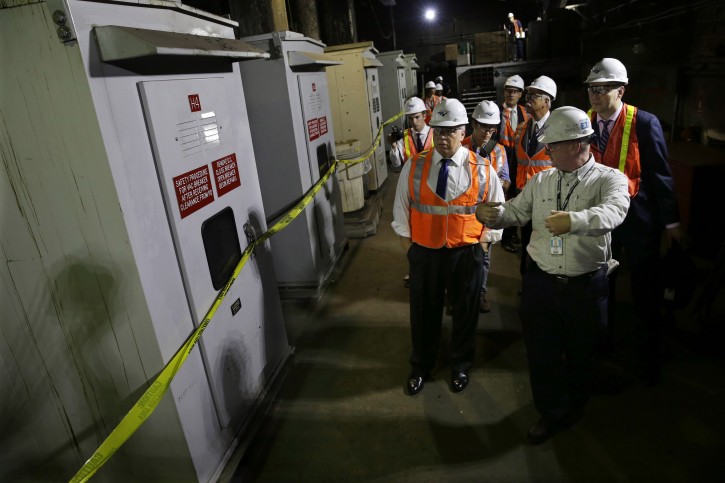 Newark, NJ – Gov. Christie and New Jersey’s two U.S. senators met with federal transportation officials Tuesday to discuss how to pay for a new rail tunnel under the Hudson River, a get-together notable for the absence of New York Gov. Andrew Cuomo, a major stakeholder in the proposed project.
Newark, NJ – Gov. Christie and New Jersey’s two U.S. senators met with federal transportation officials Tuesday to discuss how to pay for a new rail tunnel under the Hudson River, a get-together notable for the absence of New York Gov. Andrew Cuomo, a major stakeholder in the proposed project.
Subscribe to our Daily Roundup Email
Transportation Secretary Anthony Foxx reached out to Cuomo and Christie last month after electrical problems in the existing 105-year-old tunnel caused delays on several days, further incensing commuters who already contend with regular backups on the nation’s busiest rail corridor.
In a letter three weeks ago, Foxx invited the two governors to discuss the tunnel project, but Cuomo, a Democrat, said last week that he would not attend, saying any meeting to discuss the tunnel project was premature. On Thursday, The Associated Press asked a Cuomo spokeswoman about Tuesday’s meeting and was told the governor’s stance had not changed.
On Tuesday, however, Cuomo’s office seemingly backtracked, saying they had not been invited to Tuesday’s meeting. They did not immediately respond when asked whether they would have sent a representative.
In addition to Christie, a Republican, New Jersey’s two Democratic senators, Bob Menendez and Cory Booker, attended the meeting along with New Jersey transportation officials. John Degnan, chairman of the Port Authority of New York and New Jersey, also was scheduled to attend.
Foxx and Christie didn’t comment on their way into the meeting. Menendez said he hoped to discuss a number of possible funding scenarios with Foxx for the estimated $14 billion project to build a new tunnel, add track capacity and expand New York’s Penn Station.
Last month’s electrical failures, centered on 80-year-old cables likely damaged by Superstorm Sandy in 2012, reignited the debate over how to pay for a second tunnel and other improvements.
Meanwhile, rail experts and Amtrak officials say that, while a new tunnel will improve reliability, it won’t suddenly double the number of trains between New Jersey and New York. That’s because the existing tunnel will be closed for repairs for a minimum of two years once a new one is built.
In addition, two new tracks will need to be added between New Jersey stations Newark and Secaucus, where two currently exist. And, perhaps more critical, New York’s Penn Station needs to be expanded to accommodate the increased traffic.
“The tunnel work is like taking a two-lane highway and making it four-lane,” said Drew Galloway, Amtrak’s chief of planning and performance on the Northeast corridor. “But if it’s bracketed by two-lane highways on both sides, you’re not really increasing capacity.”
On a tour of the tunnel and electrical system at Penn Station Monday that included Amtrak officials and New Jersey Senate President Stephen Sweeney, the scope of the problem became more evident — and not only because, as if on cue, a disabled train earlier in the morning had caused an hour’s backup.
Inside the tunnel, the electrical cables sit inside walls that were inundated with saltwater from Superstorm Sandy in 2012. Because of the cables’ age and configuration, it can take several days to locate the source of an electrical problem, Amtrak officials said. Fixing it is time-consuming and only a handful of companies are qualified to do the work.
Currently, Amtrak workers can perform routine maintenance in the tunnel only for a few hours overnight and on weekends when one of the tunnel’s two tubes is routinely taken out of service, said Stephen Gardner, Amtrak’s vice president of Northeast Corridor infrastructure investment. If a new tunnel is built, one tube at a time would be closed for a year to 18 months each for a complete overhaul.
“There’s a desire to focus on the tunnels first, and get them built, which creates redundancy but doesn’t increase capacity,” said Richard Barone, director of transportation programs for the Regional Plan Association, a research and advocacy organization. “Then if you want to utilize the capacity of all four, you’d have to make more investment in Penn Station.”
Some elements of the project already are in motion. For example, environmental and design work has been completed for a replacement for the 105-year-old Portal Bridge over the Hackensack River, a regular source of delays. And regulatory approval for Amtrak to address adding capacity on the tracks and in Penn Station, a process begun in 2012, could be completed sometime next year, Galloway said.
The rest will be dictated by when, and how much, funding is available.
“We’re not asking for anything extraordinary; we’re asking for something to correct the problem,” Sweeney said Monday. “We can’t put this forward as a matter of a wish list, we have to put it forward as a priority.”

Simple stop welfare and food stamps and use money for this.